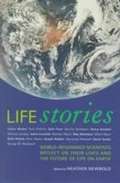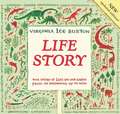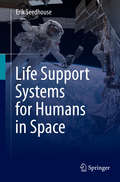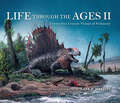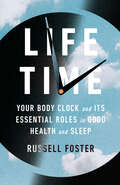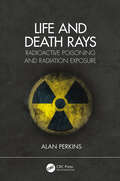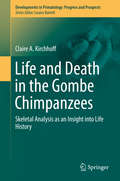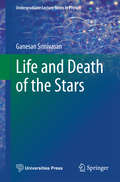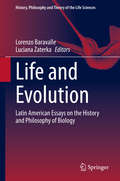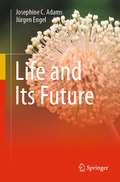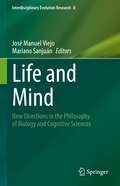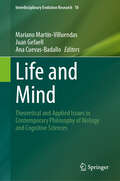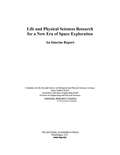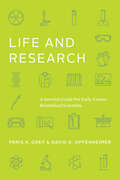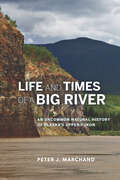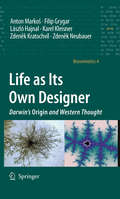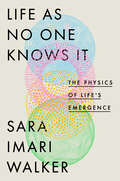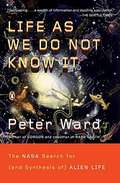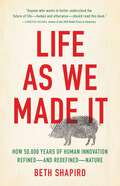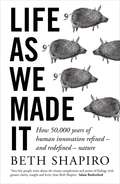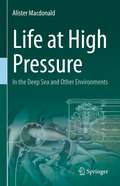- Table View
- List View
Life Stories: Well-Renowned Scientists Reflect on Their Lives and the Future of Life on Earth
by Heather Newbold"THIS BOOK IS FOR PEOPLE WHO WANT TO KNOW WHAT IS Happening to life on Earth-and to us. This knowledge is so important for our survival that I invited prominent scientists who investigate the planet's life-support system to tell their stories for our benefit. It is rare for scientists to discuss publicly their experiences, emotions, and beliefs because such expression is considered unscientific. This collection of personal and professional reflections is exceptional for its revelation of scientists' private lives and thoughts. Their profound understanding, appreciation, and reverence for life is inspirational and potentially transformative. We can experience it by following the development of their awareness, knowledge, and wisdom through their lives. These leading scientists began their careers in different scientific fields-in chemistry, nuclear physics, engineering, astronomy, and meteorology, as well as in the life sciences. In the forefront of their disciplines, they researched diverse aspects of the biosphere, yet reached convergent conclusions regarding the plight of our planet."
Life Story
by Virginia Lee BurtonEarth takes center stage in this updated version of Virginia Lee Burton's 1962 classic Life Story. Told through five acts, Burton's art and text tell the history of earth from beginning to present day. Readers will gain an in-depth understanding of the planet's history and their leading roles in it today. The book has been updated with cutting-edge science, including up-to-the-minute information on fossil records and the geologic principles. We are thrilled to provide this updated artistic and visionary work in time for the anniversary of Virginia Lee Burton's 100th birthday.
Life Structure and Function (Inspire Science #Grade 6 Integrated, Unit 1)
by Douglas Fisher Ralph M. Feather Jr. Alton L. BiggsNIMAC-sourced textbook
Life Support Systems for Humans in Space
by Erik SeedhouseLife support systems are an integral part of crewed spacecraft designs and habitation systems. This textbook introduces the LSS capabilities that sustain humans who live and work in space, and it is written at a level appropriate for both undergraduate and postgraduate students.The book begins with the basics of space physiology before detailing the features that make up different kinds of life support systems. It includes concise descriptions of how atmospheric pressure is monitored, how oxygen levels are maintained, how waste management is achieved and how water is recycled, and also describes the processes of fire detection and suppression. Several chapters are devoted to chronicling the evolution of life support systems through the decades. Each chapter includes a list of learning objectives, summary sections and review questions. Additionally, various analogs for spaceflight life support systems are examined, including nuclear submarines and our natural life support system here on Earth! Overall, this book serves as an approachable primer for any student seeking to understand the intricacies of spacecraft life support systems.
Life Through the Ages II: Twenty-first Century Visions of Prehistory (Life Of The Past Ser.)
by Mark P. WittonA paleontologist shows what life was like on our planet long before the early humans emerged through words and illustrations. Paleontologist Dr. Mark P. Witton draws on the latest twenty-first century discoveries to re-create the appearances and lifestyles of extinct, fascinating species, the environments they inhabited, and the challenges they faced living on an ever-changing planet. A worthy successor to Charles Knight&’s beloved 1946 classic, Life through the Ages II takes us on an unforgettable journey through the evolution of life on Earth. Dozens of gorgeous color illustrations and meticulously researched, accompanying commentary showcase the succession of lost worlds, defining events, and ancient creatures that have appeared since the earth was formed, creating an indispensable guide to explore what came before us.&“When it comes to modern palaeoartists, Mark Witton has become a leading light. Life Through the Ages II is a beautiful palaeoart portfolio that pushes the envelope where realistic compositions and reconstructions are concerned.&” —The Inquisitive Biologist
Life Time: Your Body Clock and Its Essential Roles in Good Health and Sleep
by Russell FosterA guide to using the science of the body clock to create the optimum personal routine. Sleep better, work better, feel better. &“Full of surprising and useful facts. . . . Unlike many science books with similar subtitles, it really might &‘revolutionise&’ your life.&”—James McConnachie, The Times (London) &“A comprehensive manifesto for living in harmony with our body clocks, penned by someone who has devoted his career to studying them.&”―Financial Times The routines of our modern lives—home working, night shifts, technology—are playing havoc with our body clocks, sleep patterns, and health. Packed with cutting edge science, this book by award-winning scientist Russell Foster takes the reader on a journey through our days and nights, and explains how we can get back into rhythm and live healthier, sharper lives. In the past few decades, there has been an explosion of discoveries around the science of the body clock and our twenty-four-hour biological cycles. Sleep and daily rhythms emerge from our genetics, physiology, behavior, and the environment. Like most of our behaviors, they are not fixed. These rhythms are modified by our actions, how we interact with the environment, and how we progress from birth to old age. Cutting through long-standing myths, Foster empowers readers by providing concrete information and guidance that can be used to understand what makes the body clock &“tick.&”
Life and Death Rays: Radioactive Poisoning and Radiation Exposure
by Alan PerkinsThis unique book provides an accessible introduction to both the scientific background and the key people involved in the discovery and use of radiation and radioactivity. It begins by providing a short history of radiation exposures and radiation poisoning; from the early inappropriate use of X-rays and radium cures through the misadventures of the Manhattan Project and the Chernobyl disaster, to the high-profile and deliberate poisoning of Alexander Litvinenko in London with polonium-210, which gave rise to worldwide media attention. The chapters provide a catalogue of deliberate criminal acts, unfortunate accidents, and inadvertent radiation exposures, exploring well-known events in detail, as well as some not so well-known occurrences. It works through the topics by focusing on human stories and events and their biological impact. In addition, it covers descriptions of the beneficial uses of radiation and radioactivity. This book can be enjoyed by any reader with a general interest in science, as well as by students and professionals within the scientific and medical communities. Key features Authored by a subject area specialist who has worked in both clinical practice and academia and was involved with the national media following incidents of national and international importance Provides a unique human perspective into well-known and some lesser known events and a concise history of the discovery of radiation and the events that followed Adds scientific and medical background to a subject of high media interest
Life and Death in the Gombe Chimpanzees: Skeletal Analysis as an Insight into Life History (Developments in Primatology: Progress and Prospects)
by Claire A. KirchhoffThis book addresses how skeletons can inform us about behavior by describing skeletal lesions in the Gombe chimpanzees, relating them to known life histories whenever possible, and analyzing demographic patterns in the sample. This is of particular interest to both primatologists and skeletal analysts who have benefited from published data on a smaller, earlier skeletal sample from Gombe. The Gombe skeletal collection is the largest collection of wild chimpanzees with known life histories in existence, and this work significantly expands the skeletal sample from this long-term research site (49 chimpanzees). The book explores topics of general interest to skeletal analysts such as demographic patterns, which injuries leave signs on the skeleton, and rates of healing, and discusses both qualitative and quantitative analysis of the patterning of lesions. The book presents the data in a narrative style similar to that employed in Dr. Goodall’s seminal work The Chimpanzees of Gombe. Readers already familiar with the Gombe chimpanzees are likely to appreciate summaries of life events correlated to observable skeletal features. The book is especially relevant at this time to remind primate conservationists of the importance of the isolated chimpanzee population at Gombe National Park as well as the availability of the skeletons for study, both within the park itself as well as at the University of Minnesota.
Life and Death of the Stars
by Ganesan SrinivasanThis volume is devoted to one of the fascinating things about stars: how they evolve as they age. This evolution is different for stars of different masses. How stars end their lives when their supply of energy is exhausted also depends on their masses. Interestingly, astronomers conjectured about the ultimate fate of the stars even before the details of their evolution became clear. Part I of this book gives an account of the remarkable predictions made during the 1920s and 1930s concerning the ultimate fate of stars. Since much of this development hinged on quantum physics that emerged during this time, a detailed introduction to the relevant physics is included in the book. Part II is a summary of the life history of stars. This discussion is divided into three parts: low-mass stars, like our Sun, intermediate-mass stars, and massive stars. Many of the concepts of contemporary astrophysics were built on the foundation erected by Subrahmanyan Chandrasekhar in the 1930s. This book, written during his birth centenary, includes a brief biographical sketch of the brilliant scientist, which readers will find fascinating. Reading this book will get young students excited about the presently unfolding revolution in astronomy and the challenges that await them in the world of physics, engineering and technology. General readers will also find the book appealing for its highly accessible narrative of the physics of stars. This book is a companion volume of "What are the Stars?" by the same author. "I know of no other book on the evolution of stars of a similar scope and breadth that is so accessible for undergraduate students. " E P J van den Heuvel Professor of Astrophysics Winner of the Spinoza and Descartes PrizesUniversity of Amsterdam, The Netherlands
Life and Evolution: Latin American Essays on the History and Philosophy of Biology (History, Philosophy and Theory of the Life Sciences #26)
by Lorenzo Baravalle Luciana ZaterkaThis book offers to the international reader a collection of original articles of some of the most skillful historians and philosophers of biology currently working in Latin American universities. During the last decades, increasing attention has been paid in Latin America to the history and philosophy of biology, but since many local authors prefer to write in Spanish or in Portuguese, their ideas have barely crossed the boundaries of the continent. This volume aims to remedy this state of things, providing a good sample of this production to the English speaking readers, bringing together contributions from researchers working in Brazilian, Argentinean, Chilean, Colombian and Mexican universities. The stress on the regional provenance of the authors is not intended to suggest the existence of something like a Latin American history and philosophy of biology, supposedly endowed with distinctive features. On the contrary, the editors firmly believe that advances in this field can be achieved only by stimulating the integration in the international debate. Based on this assumption, the book focuses on two topics, life and evolution, and presents a selection of contributions addressing issues such as the history of the concept of life, the philosophical reflection on life manipulation and life extension, the structure and development of evolutionary theory as well as human evolution. Life and Evolution – Latin American Essays on the History and Philosophy of Biology will provide the international reader with a rather complete picture of the ongoing research in the history and philosophy of biology in Latin America, offering a snapshot of this dynamic community. It will also contribute to contextualize and develop the debate concerning life and evolution, and the relation between the two phenomena.
Life and Its Future
by Jürgen Engel Josephine C. AdamsThis book is aimed at those who wish to understand more about the molecular basis of life and how life on earth may change in coming centuries. Readers of this book will gain knowledge of how life began on Earth, the natural processes that have led to the great diversity of biological organisms that exist today, recent research into the possibility of life on other planets, and how the future of life on earth faces unprecedented pressures from human-made activities. Readers will obtain a perspective on the potential risks of chemical or nuclear warfare, and the ever-increasing risks from human activities that are causing pollution and climate change with global heating. Readers will also learn about ongoing research efforts to generate “designer lifeforms” through synthetic biology and applications of artificial intelligence. The book makes an integrated, up-to-date, overview of topics often considered as separate fields. It should be valuable to students, teachers, and people who are concerned about the future of life.
Life and Mind: New Directions in the Philosophy of Biology and Cognitive Sciences (Interdisciplinary Evolution Research #8)
by José Manuel Viejo Mariano SanjuánThis volume provides a broad overview of some cutting-edge philosophical topics of growing interest at the juncture between cognitive science and biology. The main goal is not to integrate the variety of approaches into a single account, but rather to offer diverse perspectives on a collection of selected biological issues of particular philosophical relevance, reflecting the plurality of current research in these areas. Four conceptual vectors give this volume its coherence: Animal and human cognition: With respect to animal cognition, this volume focuses on self-awareness and methodological flaws in the science of animal consciousness. Regarding human cognition, the authors of this volume address various aspects of so-called 4E cognition. Genetics: The role of genes in the development of mind and life has always been philosophically controversial. In this volume, the authors address the possibility of considering post-genomic genes as natural kinds and the proper analysis of the concept of genotype. Teleology: This volume addresses issues of evolutionary causality and teleosemantics, as well as questions relating to biological teleology and regulation. Evolution: Evolution exemplifies better than any other concept the convergence point between philosophy, biology and cognitive sciences. Among other things, the volume deals with the origin of novelties in evolutionary processes from various viewpoints (e.g., cultural evolution and developmental plasticity). Despite their disparity, all these topics belong to a common naturalistic framework. By presenting them in a single volume, the editors want to emphasize the need to always conduct philosophical research on mind and life with tangential domains in mind.This book is a valuable resource for students and researchers of philosophy with a special interest in life, cognition, and evolution, as well as for biologists and cognitive scientists.
Life and Mind: Theoretical and Applied Issues in Contemporary Philosophy of Biology and Cognitive Sciences (Interdisciplinary Evolution Research #10)
by Mariano Martín-Villuendas Juan Gefaell Ana Cuevas-BadalloIn recent times, the philosophy of science has been reinvigorated by insights from the biological and cognitive sciences. These disciplines have provided not only new perspectives to approach traditional philosophical problems but have also opened the way to new conceptual and methodological questions that call for new and innovative solutions. This book brings together some of the main debates that have structured in the last years the fields of philosophy of biology and cognitive sciences. It is organized around 11 chapters distributed in two parts: one devoted to the philosophy of biology, and the other to the cognitive sciences. These ideas were originally presented at the 11th edition of the International Philosophy of Biology and Cognitive Science (PBCS-XI) workshop held in 2022 in Salamanca, Spain. Part I of the volume is devoted to topics related to the philosophy of biology and includes hot topics such as “biological functions”, “modelization”, “pain medicine”, or “organicism”. Part II is devoted to debates in the cognitive sciences and includes issues related to "ecological psychology", "enactivism", "FEP" or "animal cognition". Considering the diversity of the topics covered in this volume, the book is purposely conceived to serve as an updated introduction to the fields of the philosophy of biology and cognitive sciences for those researchers interested in having a panoramic view of these two areas of inquiry. But not only that, the detailed and scholarly coverage of the topics included renders this book appealing to a much more specialized audience interested in particular aspects of each of the debates already mentioned.
Life and Physical Sciences Research for a New Era of Space Exploration: An Interim Report
by National Research Council of the National AcademiesIn response to requests from Congress, NASA asked the National Research Council to undertake a decadal survey of life and physical sciences in microgravity. Developed in consultation with members of the life and physical sciences communities, the guiding principle for the study is to set an agenda for research for the next decade that will allow the use of the space environment to solve complex problems in life and physical sciences so as to deliver both new knowledge and practical benefits for humankind as we become a spacefaring people. The project's statement of task calls for delivery of two books--an interim report and a final survey report. Although the development of specific recommendations is deferred until the final book, this interim report does attempt to identify programmatic needs and issues to guide near-term decisions that are critical to strengthening the organization and management of life and physical sciences research at NASA.
Life and Research: A Survival Guide for Early-Career Biomedical Scientists (Chicago Guides to Academic Life)
by Paris H. Grey David G. OppenheimerLife in a research lab can be daunting, especially for early-career scientists. Personal and professional hurdles abound in bench research, and this book by two seasoned lab professionals is here to help graduate students, postdocs, and staff scientists recognize stumbling blocks and avoid common pitfalls. Building and maintaining a mentoring network, practicing self-care and having a life outside of the lab, understanding that what works perfectly for a labmate might not work for you—these are just a few of the strategies that lab manager and molecular biologist Paris H. Grey and PI and geneticist David G. Oppenheimer wished they had implemented far sooner in their careers. They also offer practical advice on managing research projects, sharing your work on social media, and attending conferences. Above all, they coach early-career scientists to avoid burnout and make the most of every lab experience to grow and learn.
Life and Research: A Survival Guide for Early-Career Biomedical Scientists (Chicago Guides to Academic Life)
by Paris H. Grey David G. OppenheimerLife in a research lab can be daunting, especially for early-career scientists. Personal and professional hurdles abound in bench research, and this book by two seasoned lab professionals is here to help graduate students, postdocs, and staff scientists recognize stumbling blocks and avoid common pitfalls. Building and maintaining a mentoring network, practicing self-care and having a life outside of the lab, understanding that what works perfectly for a labmate might not work for you—these are just a few of the strategies that lab manager and molecular biologist Paris H. Grey and PI and geneticist David G. Oppenheimer wished they had implemented far sooner in their careers. They also offer practical advice on managing research projects, sharing your work on social media, and attending conferences. Above all, they coach early-career scientists to avoid burnout and make the most of every lab experience to grow and learn.
Life and Research: A Survival Guide for Early-Career Biomedical Scientists (Chicago Guides to Academic Life)
by Paris H. Grey David G. OppenheimerLife in a research lab can be daunting, especially for early-career scientists. Personal and professional hurdles abound in bench research, and this book by two seasoned lab professionals is here to help graduate students, postdocs, and staff scientists recognize stumbling blocks and avoid common pitfalls. Building and maintaining a mentoring network, practicing self-care and having a life outside of the lab, understanding that what works perfectly for a labmate might not work for you—these are just a few of the strategies that lab manager and molecular biologist Paris H. Grey and PI and geneticist David G. Oppenheimer wished they had implemented far sooner in their careers. They also offer practical advice on managing research projects, sharing your work on social media, and attending conferences. Above all, they coach early-career scientists to avoid burnout and make the most of every lab experience to grow and learn.
Life and Suicide Following Brain Injury: A Personal and Professional Account (After Brain Injury: Survivor Stories)
by Alyson NormanLife and Suicide Following Brain Injury tells the story of Tom, a 43 year-old man who acquired a brain injury from a road traffic accident at the age of 22. Tom survived but went on to take his own life 20 years later. As a vulnerable adult with mental health issues and long-term difficulties with substance misuse, this book tells Tom's story from his early childhood through to his death. In telling Tom's story, the author- a researcher in the brain injury field and Tom's sister- identifies the multiple suicide risk factors as well as the lack of understanding and inadequate service provision for people with complex needs following TBI. His story serves as a harrowing example of what can go wrong when timely intervention and support is not forthcoming, identifying a multitude of risk factors and possible points of intervention to improve care in the future. This book provides insight to professionals and academics across health and social care in the risks of suicide associated with TBI. It also provides support for those who have experienced the grief of losing a survivor to suicide, or those struggling to support a survivor who is suicidal.
Life and Times of a Big River: An Uncommon Natural History of Alaska's Upper Yukon
by Peter J. MarchandWhen Richard Nixon signed the Alaska Native Claims Settlement Act in 1971, eighty million acres were flagged as possible national park land. Field expeditions were tasked with recording what was contained in these vast acres. Under this decree, five men were sent into the sprawling, roadless interior of Alaska, unsure of what they’d encounter and ultimately responsible for the fate of four thousand pristine acres. Life and Times of a Big River follows Peter J. Marchand and his team of biologists as they set out to explore the land that would ultimately become the Yukon-Charley Rivers National Preserve. Their encounters with strange plants, rare insects, and little-known mammals bring to life a land once thought to be static and monotonous. And their struggles to navigate and adapt to an unforgiving environment capture the rigorous demands of remote field work. Weaving in and out of Marchand's narrative is an account of the natural and cultural history of the area as it relates to the expedition and the region’s Native peoples. Life and Times of a Big River chorincles this riveting, one-of-a-kind journey of uncertainty and discovery from a disparate (and at one point desperate) group of biologists.
Life as Its Own Designer
by Zdenek Neubauer László Hajnal Zdenek Kratochvíl Filip Grygar Karel Kleisner Anton MarkošIt has been nearly 150 years since Darwin published On the Origin of Species, and his theory of natural selection still ignites a forest of heated debate between scientific fundamentalists on the one hand and religious fundamentalists on the other. But both sides actually agree more than they disagree, and what has long been needed is a third way to view evolution, one that focuses more on the aspect of life and "being alive", one that can guide us through, and perhaps out of, the fiery thicket. This book, a seminal work in the burgeoning field of Biosemiotics, provides that third way, by viewing living beings as genuine agents designing their communication pathways with, and in, the world. Already hailed as the best account of biological hermeneutics, Life As Its Own Designer: Darwin's Origin and Western Thought is a wholly unique book divided into two parts. The first part is philosophical and explores the roots of rationality and the hermeneutics of the natural world with the overriding goal of discovering how narrative can help us to explain life. It analyzes why novelty is so hard to comprehend in the framework of Western thinking and confronts head-on the chasm between evolutionism and traditional rationalistic worldviews. The second part is scientific. It focuses on the life of living beings, treating them as co-creators of their world in the process of evolution. It draws on insights gleaned from the global activity of the Gaian biosphere, considers likeness as demonstrated on homology studies, and probes the problem of evo-devo science from the angle of life itself. This book is both timely and vital. Past attempts at a third way to view evolution have failed because they were written either by scientists who lacked a philosophical grounding or New Age thinkers who lacked biological credibility. Markoš and his coworkers form an original group of thinkers supremely capable in both fields, and they have fashioned a book that is ideal for researchers and scholars from both the humanities and sciences who are interested in the history and philosophy of biology, biosemiotics, and the evolution of life.
Life as No One Knows It: The Physics of Life's Emergence
by Sara Imari WalkerAn intriguing new scientific theory that explains what life is and how it emerges.What is life? This is among the most difficult open problems in science, right up there with the nature of consciousness and the existence of matter. All the definitions we have fall short. None help us understand how life originates or the full range of possibilities for what life on other planets might look like.In Life as No One Knows It, physicist and astrobiologist Sara Imari Walker argues that solving the origin of life requires radical new thinking and an experimentally testable theory for what life is. This is an urgent issue for efforts to make life from scratch in laboratories here on Earth and missions searching for life on other planets.Walker proposes a new paradigm for understanding what physics encompasses and what we recognize as life. She invites us into a world of maverick scientists working without a map, seeking not just answers but better ways to formulate the biggest questions we have about the universe. The book culminates with the bold proposal of a new theory for identifying and classifying life, one that applies not just to biological life on Earth but to any instance of life in the universe. Rigorous, accessible, and vital, Life as No One Knows It celebrates the mystery of life and the explanatory power of physics.
Life as We Do Not Know It
by Peter WardAn engrossing and revelatory first look at the search for alien life-on Earth and beyond For the past twenty years, Peter Ward has been at the forefront of popular science writing, with books such as the influential and controversial Rare Earth. In Life as We Do Not Know It, Ward, with his signature blend of eloquence, humor, and learned insight, vividly details the latest scientific findings, cutting-edge research, and intrepid new theories on the subject of alien life and the possible extraterrestrial origins of life on Earth. In lucid, entertaining, and bold prose, Peter Ward once again challenges our notions of life on earth (and beyond). .
Life as We Made It: How 50,000 Years of Human Innovation Refined—and Redefined—Nature
by Beth ShapiroFrom the first dog to the first beefalo, from farming to CRISPR, the human history of remaking nature When the 2020 Nobel Prize was awarded to the inventors of CRISPR, the revolutionary gene-editing tool, it underlined our amazing and apparently novel powers to alter nature. But as biologist Beth Shapiro argues in Life as We Made It, this phenomenon isn&’t new. Humans have been reshaping the world around us for ages, from early dogs to modern bacteria modified to pump out insulin. Indeed, she claims, reshaping nature—resetting the course of evolution, ours and others&’—is the essence of what our species does. In exploring our evolutionary and cultural history, Shapiro finds a course for the future. If we have always been changing nature to help us survive and thrive, then we need to avoid naive arguments about how we might destroy it with our meddling, and instead ask how we can meddle better. Brilliant and insightful, Life as We Made It is an essential book for the decades to come.
Life as We Made It: How 50,000 years of human innovation refined – and redefined – nature
by Beth ShapiroFrom the very first dog to glowing fish and designer pigs – the human history of remaking nature. Virus-free mosquitoes, resurrected dinosaurs, designer humans – such is the power of the science of tomorrow. But this idea that we have only recently begun to manipulate the natural world is false. We&’ve been meddling with nature since the last ice age. It&’s just that we&’re getting better at it – a lot better. Drawing on decades of research, Beth Shapiro reveals the surprisingly long history of human intervention in evolution through hunting, domesticating, polluting, hybridizing, conserving and genetically modifying life on Earth. Looking ahead to the future, she casts aside the scaremongering myths on the dangers of interference, and outlines the true risks and incredible opportunities that new biotechnologies will offer us in the years ahead. Not only do they present us with the chance to improve our own lives, but they increase the likelihood that we will continue to live in a rich and biologically diverse world.
Life at High Pressure: In the Deep Sea and Other Environments
by Alister MacdonaldThe book discusses the ways in which high hydrostatic pressure (i.e. water pressure) affects all grades of life which thrive at pressures much greater those in our normal environment. The deep sea is the best known high pressure environment, where pressures reach a thousand times greater than those at the surface, yet it is populated by a variety of animals and microorganisms. The earth’s crust supports microorganisms which live in water filled pores at high pressure. In addition, the load bearing joints of animals like ourselves experience pulses of hydrostatic pressure of a magnitude similar to the pressure at mid ocean depths.These pressures affect molecular structures and biochemical reactions. Basic cellular processes are drastically affected – the growth and division of cells, the way nerves conduct impulses and the chemical reactions which provide energy. Adaptation to high pressure also occurs in complex physiological systems such as those which provide buoyancy. Probably the greatest challenge to our understanding of adaptation to high pressure is the stabilisation of the nervous system of deep sea animals to avoid convulsions which pressure causes in shallow water animals. Additionally the book provides insight into the engineering required to study life at high pressure: equipment which can trap small deep sea animals and retrieve them at their high pressure, equivalent equipment for microorganisms, laboratory microscopes which can focus on living cells under high pressure, incubators for bacteria which require high pressure to grow, high pressure aquaria for marine animals and lastly and briefly, manned and unmanned submersible vessels, Landers and deep drill hole sampling. Rather like the organisms studied many laboratory instruments have been adapted to function at high pressure.
